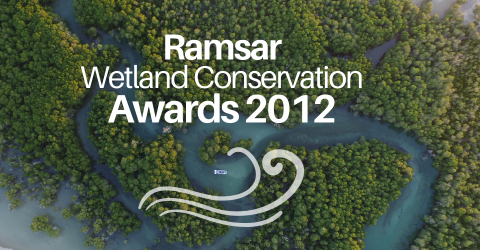
Recognition of Achievement 2012
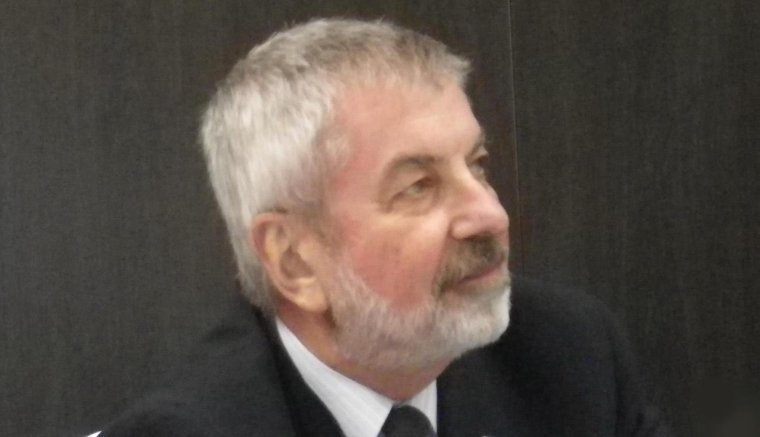
Thymio Papayannis, Greece
Thymio Papayannis has been working on wetland conservation, wise use and the cultural values of wetlands, and with the Convention on Wetlands for 26 years, in the framework Greece, the Mediterranean and globally. He has played a key role in the establishment of important research institutes and organisations in natural environment and culture, such as WWF Greece, the Society for the Protection of Prespa (in which he has succeeded Luc Hoffmann as President), Med-INA, the Mediterranean Institute for Nature and Anthropos (of which he is the Director) and the Greek Biotope Wetland Centre (EKBY, a research centre on wetlands issues). On a Mediterranean scale, he was instrumental in establishing in 1991 the MedWet Initiative, and in its implementation as a Coordinator for its first 10 years (in which he remains as Senior Advisor). He has also been a Board member of WWF International and of the Tour du Valat Foundation (for nearly 20 years), as well as joint Coordinator of the IUCN Delos Initiative on sacred natural sites. Thymio Papayannis’s work and his books have contributed significantly to an overall better understanding and awareness of Mediterranean wetland issues and challenges. His work has inspired a number of research and development programmes and institutions. For many years, he has advised the Secretariat of the Convention on Wetlands and made a major contribution to the incorporation of cultural values in the work of the Convention and has coordinated the work of the Ramsar Culture Working Group. Thymio Papayannis is a visionary leader that personifies the Ramsar Recognition of Achievement Award.
Interview with Thymio Papayannis
You are an architect by profession. How did you become interested in wetland conservation? And why wetlands?
Although I have been working as an architect and planner for many years, responsible for the design of major public, commercial and private buildings –through TPA, a large multidisciplinary consulting firm I established in 1958 and still quite active–, my interests have never been static. Thus, my professional work focussed first on building design, then on city planning and finally on regional planning.
In the early 1980s, coordinating a conservation and mild development project for Amvrakicos Gulf in Western Greece –funded by the European Commission– brought me in touch with the natural heritage of the country, and in particular wetlands. As Amvrakicos Gulf was a Ramsar Site, the project created an entry point to the understanding of the Convention on Wetlands. This was reinforced by the acquaintance with key wetland experts in an EC-organised group, such as Luc Hoffmann, Mike Smart, Ed Maltby, Ted Hollis and Reinhard Klein. Luc Hoffmann convinced me easily of the need to work and to fight for the protection of the rich natural heritage of Greece, initially and of the Mediterranean later on. Reinhard Klein appointed me representative of the European Commission for matters related to nature in Greece and proved to be highly supportive for conservation actions. Between these two influences my interests shifted more and more to nature conservation and especially to wetlands. Gradually, I realised that adding new buildings on this Earth, even if designed by good architects, was less important than protecting valuable ecosystems; and to this task I dedicated a large part of my life.
Wetlands in particular fascinated me because of their diversity and the mobility of their landscapes through the presence –or at time the absence– of water, leading to unique landscapes, with an ever-present human implication and a great contribution to biodiversity.
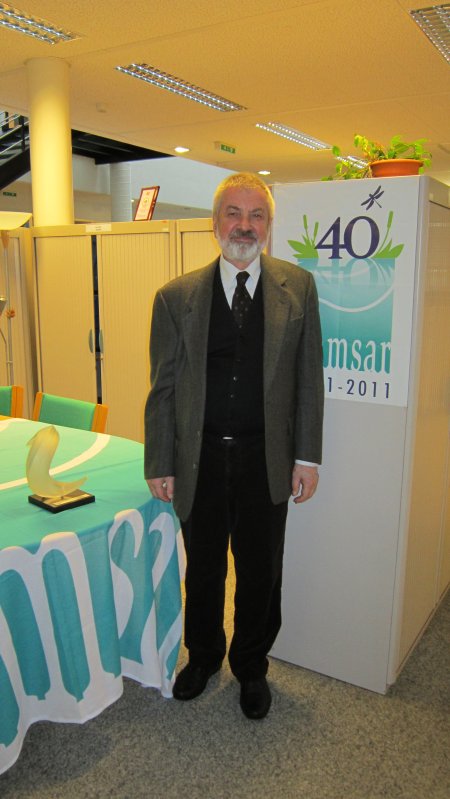
Some of us at the Convention Secretariat have known you for many years, and remember that you were interested in the cultural values of wetlands from an early stage of your involvement with wetlands. It was an unusual focus at the time; how did it start?
Working on wetland conservation, I learned gradually of the intimate links between human beings and water-related ecosystems, established by the continuous use of their resources and services. During the twentieth century, however, these links were weakened as traditional activities were gradually abandoned, reducing substantially the cultural values associated with wetlands. Some of us realised that the human part of the equation was crucial in achieving wetland conservation and we felt the need for re-establishing the links between human beings and wetlands through a rediscovery and enhancement of their cultural values.
This concept was promoted first in the Mediterranean –in cooperation with SEHUMED and professor María José Viñals, and then in 2001 Delmar Blasco, the Convention's Secretary General at that time, asked me to undertake introducing cultural values in the work of the Convention. This led to the approval of Resolutions VIII.19 in 2002 and IX.21 in 2005 –the second under Peter Bridgewater, the establishment of the Ramsar Culture Working Group and the publication of the Ramsar Guidance on Culture and Wetlands in 2008.
Our work in the Mediterranean concerning the cultural values of wetlands continued through Med-INA with the publication of three books on culture and wetlands (see below).
Twenty years ago, you were involved in the creation of MedWet, the first Ramsar regional initiative; how did you get involved and what was the basis for the creation of this initiative?
In February 1991, a group of wetland experts organised in the Italian town of Grado in Northern Italy a major event, the Grado Symposium on Mediterranean Wetlands and their Birds. During this Symposium, the 400 participants documented in great detail the enormous losses of wetlands around the Basin, while some of us were trying in parallel to envisage ways to stop this degradation and destruction, through the Grado declaration and Strategy. At the end of the event, however, a small group led by Luc Hoffmann realised that there was the danger after the Grado Symposium of doing nothing concrete beyond the approval of some fine documents. In this context, my proposal to try to bring together all those concerned with Mediterranean wetlands (governments, inter-governmental and nongovernmental organisations and individuals) seemed worth a try. A five member Coordination Group was formed and I was asked to chair it. A year later, the first MedWet project was launched, with the strong support of the European Commission, through Reinhard Klein. It concerned mainly the preparation of the necessary methods and tools for wetland management, including management, inventories, research, public awareness and education, as well as a pragmatic strategy. The strategy was approved in a meeting in Venice in May 1996, while shortly after the Convention's Standing Committee approved the establishment of the Mediterranean Wetlands Committee, as the first Ramsar regional advisory body, bringing together the major stakeholders in the region, including 27 governments, 4 international agreements and 7 major NGOs and wetland centres.
I coordinated MedWet during its first decade, was elected Honorary Member of MedWet/Com in 2001 and, since then, have been continuously involved with MedWet as Senior Advisor. Currently, I have been chairing the Organising Committee for the International Conference on Water and Wetlands in the Mediterranean – The next 20 years to be held in Agadir, Morocco on 6-8 February 2012, under the aegis of the Convention on Wetlands. (See below for more information).
Please also tell us about your role in other organizations (WWF International and WWF Greece) and about the other institutions whose birth you have accompanied (Med-Ina, the Mediterranean Institute for Nature and Anthropos, or the Greek Biotope Wetland Centre (EKBY))?
Working closely with Luc Hoffmann in the late 1980s, we attempted to protect the area of Prespa Lakes in the Northwest of Greece, a rich in biodiversity Ramsar site. Our efforts brought meagre results until we founded locally the Society for the Protection of Prespa (SPP) in 1991, whose members were seven Greek NGOs, RSPB, the Danish Ornithological Society and Tour du Valat. Luc became the first President of SPP and I succeeded him in 2001. The SPP received the first Ramsar Award in 1999 and in 2000 it played a key role in the establishment of the transboundary Prespa Park shared by Albania, the FYR of Macedonia and Greece. Mainly because of our work in Prespa, the Agricultural University of Athens conferred upon me an honorary doctorate in 2009.
In 1989, a major event on Greek wetlands was organised in Thessaloniki at the initiative of Luc Hoffmann, at which I proposed the creation of a wetland centre in Greece. This was realised a few years later in the framework of the Goulandris Museum of Natural History, with the financial and moral support of the European Commission (again through Reinhard Klein) and EKBY, the Greek Biotope Wetland Centre was born.
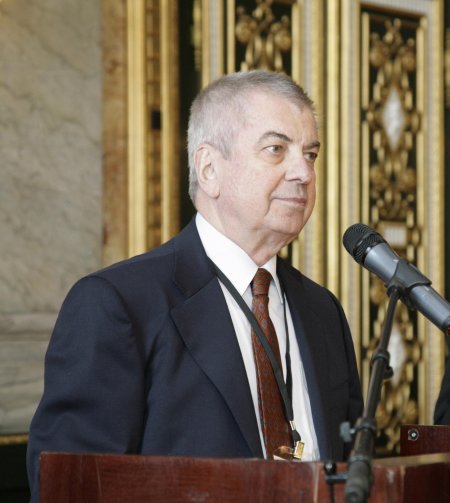
Working with Dr Hoffmann, we established in the early 1990s WWF Greece, which rapidly became a National Organisation and a Greek foundation, which I have chaired for many years. Later, I became twice trustee of WWF International and contributed to the development of its current governance system. In May 2008 I was named Member of Honour of this organisation. Currently, I am chairing its Nominations Committee.
In 2003, I established in Athens Med-INA, the Mediterranean Institute for Nature and Anthropos, a science-based non-profit organisation working on the interface of human beings and the environment, of culture and nature. Since then Med-INA has focused its activities on the cultural values of Mediterranean wetlands, on landscapes and on sacred natural sites, with the support of the MAVA Foundation. Through its work, Med-INA promotes the concept of people (Anthropos) as steward –and not exploiter– of our world.
In 2004, I proposed to IUCN/WCPA and its Specialist Group on Cultural and Spiritual Values of Protected Areas the creation of the Delos Initiative on sacred natural sites in technologically developed countries. This initiative, which we jointly coordinate with Josep-Maria Mallarach, has organised workshops in Montserrat (Catalonia, Spain), Ouranoupolis (close to Mt Athos, Northern Greece) and Inari (Northern Finland), which have promoted an integrated approach to spiritual, cultural and natural heritage. Since the early 1990s, I have also been closely involved with Mt Athos and recently have been coordinating the efforts for the integrated management of this World Heritage Site.
When did you become aware of the existence of the Convention? And how do you see your role using and supporting the Convention?
My involvement with Amvrakicos Gulf and the EC sponsored ‘Expert Group on Mediterranean-type Wetlands’ in the late 1980s led me to the discovery of the Convention on Wetlands. Officially, I was invited to present a paper on Greek wetlands at COP4 (Montreux, 1990) and have participated in all COPs since then, with various functions related to the Convention and the Convention Secretariat. Thus, Bucharest in July 2012 will be my eighth COP.
Through these years, I grew to realise that the Convention was not only a multi-lateral agreement on a high-productivity ecosystem, but also the focus of concerned and dedicated individuals that maintain a passion for wetlands and work hard for their conservation and the wise use of their resources. This ‘Ramsar Community’ has demonstrated repeatedly its usefulness in averting threats, promoting new methods and tools, responding to new challenges, while sidestepping bureaucratic constraints.
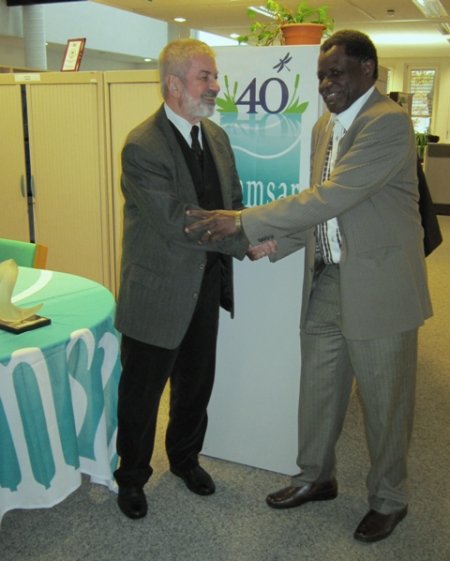
What does the Recognition of Achievement mean to you?
After the first pleasant surprise at receiving the prestigious Ramsar Award in Recognition of Achievement, I tried to understand its rationale. Indeed I have been involved with many activities for the conservation of nature and the much desired harmony between human beings and their natural environment. Many of them focused on wetlands and have been related to the Convention on Wetlands. These activities, however, would not have been possible without the active participation and commitment of very many people, who worked closely with me, developed further our ideas, corrected errors we made and continued the initiatives we have started. In my mind, it is to the work of all these people that the Recognition of Achievement is addressed.
Do you have any general messages about the importance of wise use of wetlands?
Reply: ‘Wise use’ has been often considered as synonymous with ‘sustainable use’. For me there is a difference. Information –properly processed– creates knowledge. Knowledge –carefully assessed and correlated– may lead gradually to wisdom. Thus, wise use of wetlands and of their resources and services implies a lengthy process of evaluation, integration, experimentation and feedback processed through the human intellect. It is a concept that bonds human beings with wetlands and ensures the harmony of this relationship. As such, it is broader than sustainable use and we should maintain it as a leading objective of the Convention.
Books on Wetlands:
Papayannis, T. and Salathé T. (1999), Mediterranean Wetlands at the Dawn of the 21st Century, (with Tobias Salathé), Arles: MedWet / Tour du Valat.
Papayannis, T. (2002), Regional Action for Wetlands: The Mediterranean Experience 1991-2002, October 2002, Arles: MedWet / Tour du Valat (also in French and Spanish).
Papayannis, T. (2008), Action for culture in Mediterranean wetlands, Athens: Med-INA.
Papayannis, T. and Pritchard, D.E. (2008), Culture and Wetlands: A Ramsar Guidance Document, Ramsar Culture Working Group, Gland: Ramsar.
Papayannis, T. (2010), Un patrimoine à préserver: les zones humides méditerranéennes, Paris : Buchet et Chastel.
Papayannis, T. and Pritchard D.E. (ed.) (2011), Culture and Wetlands in the Mediterranean: An Evolving Story, Athens: Med-INA